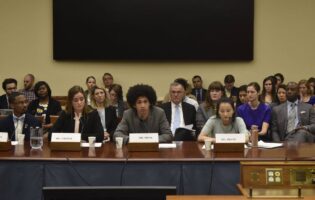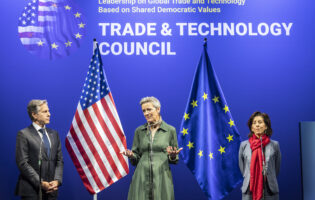
U.S. Department of State from United States [Public domain], via Wikimedia Commons
Securing the National Interests: The United States and Japanese-South Korean Reconciliation

Agnieszka Batko
Jagiellonian University
Agnieszka Batko was a Harry & Helen Gray/AICGS Reconciliation Fellow in August and September 2017. She holds an MA in International Relations from Jagiellonian University (JU) and is currently pursuing her PhD degree in Political Science at JU. She also studied at Griffith University in Australia and University of Hull in the United Kingdom. Prior to coming to AICGS, she was conducting research at Aoyama Gakuin University in Tokyo.
Her research interests include international relations in East Asia, Japanese foreign policy, the role of non-state actors in international relations, and IR theory
While at AICGS, she conducted research concerning the Japan-South Korea reconciliation process from two different perspectives: the role of the Japanese and Korean non-governmental organizations (NGOs) as well as the American governmental and non-governmental institutions within this mechanism. The first part of the project focuses on the NGOs in Japan and South Korea undertaking projects aimed at overcoming historical issues between the two states. At the same time, it addresses the issue of the false presumption that the reconciliation between those countries is being conducted only by the governments. The latter part will concentrate on investigating whether the U.S., being the most important ally of both Japan and South Korea in the Northeast Asia region, can adopt a more pro-active role in the reconciliation process through governmental as well as non-governmental channels.
The reconciliation process in Northeast Asia, notably between Japan and South Korea (Republic of Korea), is still far from being a success story. The governments of the two states have been able to normalize their relations over the last seventy-two years since the end of the Pacific War. Nevertheless, historical matters continue to impede further cooperation. The ongoing reconciliation process extends beyond the bilateral relationship as it influences the political landscape for the whole region. Consequently, the state of the current Japanese-South Korean relationship has raised questions about potential direct involvement by the United States, the most important ally for both countries in Northeast Asia. However, despite maintaining a strategic presence in the region and security ties with both Japan and South Korea, consecutive U.S. administrations have so far demonstrated restraint in involving the U.S. in the ongoing reconciliation process between the two states.
This essay will examine the reasons for such a restrained approach and introduce several initiatives and steps that can be perceived as clear indications of the U.S.’ stance on the reconciliation process between Japan and South Korea. The essay will argue that advancing this bilateral rapprochement is within the vital American interest, but that it cannot occur without recognizing the importance of historical matters in the region and remodeling the policies accordingly. Furthermore, the essay will also elaborate on the activities within the United States that concern the reconciliation issues between Japan and South Korea. This part will focus not only on demonstrating that the U.S. has, to some extent, become another battlefield of the reconciliation process, but also on explaining how those historical problems are being understood and framed internally.
The U.S. and Japanese-South Korean Reconciliation: The Historical Perspective
After defeating Japan in World War II (WWII), the United States was a decisive voice in the transformation of the Japanese political system. However, as several scholars have noted, the U.S. did not reconstruct it in a radical manner. Stefan Englert argues that America took “limited efforts to deal with the past for the sake of the early democratization and stabilization of the country.”[1] Other scholars, including Gi-Wook Shin and Jeff Kingston, have presented a similar stance.[2] The social structure was left untouched, including the position of the Emperor, who was perceived by Americans as a symbol of stability and therefore should not be judged for his involvement in the atrocities committed during occupation and war. Finding itself at the doorstep of the Cold War, Washington also needed an ally against the People’s Republic of China (PRC) and the Soviet Union in Asia. As a result, Japan was quickly recognized as a much-needed partner.
The next crucial event also marked by direct U.S. involvement was the Treaty of Peace with Japan in 1951, also called the San Francisco Treaty, signed between Japan and the Allied Powers. The document fully reflected U.S. policies but it did not include the most controversial issues between Japan and South Korea (or Japan and China for that matter), such as territorial matters or Japanese war crimes. Since the representatives of neither China nor South Korea were invited to San Francisco, no reparations were listed for either of those states.[3]
The idea of bringing Japan and South Korea closer was triggered in Washington yet again as a step linked directly to the ongoing Cold War. The U.S. needed both countries to normalize their bilateral relations due to the threat posed by the communist China and the Soviet Union as well as the war in Vietnam. As a result, the two states signed the Treaty on Basic Relations in 1965. Similar to the San Francisco Treaty, the document did not refer to the historical issues remaining after WWII even with regard to recognizing Japan as an aggressor.[4] Subsequently, South Korea received financial aid and grants from Japan, although the payments were made in the shape of “non-repayable loans” rather than reparations.[5] Yet, it has to be noted that the authoritarian regime of Park Chung-hee at the time accepted the Treaty with all its consequences as Seoul was seeking ways to boost its economy and needed the financial resources from Japan.
During the Cold War period, the U.S. government failed to recognize the importance of the historical issues in Northeast Asia. It is not to say that policymakers in Washington were not aware of the matters concerning the comfort women, controversies over the Yasukuni Shrine (where fourteen Class-A war criminals were enshrined in 1978), or the territorial dispute over Dokdo/Takeshima, for example. However, in order to pursue strategic objectives in the region, historical reconciliation was pushed to the back.
Japanese-South Korean Reconciliation Issues in the United States: The Government Response and the Potential of Civil Society
The reconciliation process between Japan and South Korea started gaining more attention, both domestically and internationally, after articles about the comfort women were published in Japan in the 1980s.[6] The evidence regarding the system of military brothels was subsequently strengthened by the testimonies of the surviving Asian and Dutch women. Interestingly, documentation regarding the comfort women has also been found in the United States. First, the research report titled “Amenities in the Japanese Armed Forces” produced by Allied Translator and Interpreter Section, Supreme Commander of the Allied Powers, dated 15 November 1945, was declassified in 1992. It not only reveals several details concerning the comfort stations, but above all confirms the direct involvement of the Japanese military authorities in their establishment.[7] What is more, the Congressional Research Service (CRS) Memorandum from 2007 mentions three records kept in the U.S. National Archives: (1) a report to the U.S. government by Horace H. Underwood, an American missionary in Korea, in which he mentions the recruitment of women, (2) the U.S. Office of War Information report from October 1944 that includes an interview of twenty Korean women found in northern Burma after its liberation, (3) a report from the U.S. Office of Strategic Services dated May 1945 containing interviews of twenty-three Korean women found in China who escaped the Japanese army and reached Chinese territory.[8] Yet again, the existence of such documents raises a question of whether the United States should be more directly involved in the ongoing Japan-South Korea reconciliation process, as despite being aware of the war atrocities, it did not exert pressure on Tokyo to apologize or offer compensation.
After the reports on the comfort women as well as the testimonies of the survivors emerged, the issue was also brought up in the U.S. Congress. Policymakers in Washington were primarily concerned with the lack of unambiguous apology and reparations for the surviving comfort women from the government of Japan. The momentum for a House of Representatives resolution regarding this issue started gaining traction during Junichirō Koizumi’s tenure as prime minister in 2005 to 2006 and after he was replaced by Shinzō Abe from 2006 to 2007. During Prime Minister Koizumi’s tenure, Congressman Lane Evans introduced two House of Representatives Resolutions regarding the comfort women. However, neither was approved.[9] In response to the comments made by Prime Minister Abe about the comfort women,[10] Congressman Michael Honda introduced H. Res. 121 in January 2007 which was unanimously approved in July 2007. Whereas the language of H. Res 121 was softened compared to the previous projects, it most importantly recognized the comfort women as “one of the largest cases of human trafficking in the twentieth century” and called for acknowledgement and apologies from the Government of Japan.[11] Abe visited the U.S. in April that year, before the Resolution was brought to vote, and the comfort women issue was discussed during the joint press conference. President George W. Bush expressed acceptance of Abe’s apologies and that the next step was to lead both nations forward.[12] This statement has in a way confirmed the nature of the U.S. policy toward Japanese-South Korean reconciliation, emphasizing the willingness to move forward in order to reach the current political objectives.
The administration of President Barack Obama largely followed and expanded this approach. With the “pivot” to Asia strategy, policymakers recognized the need to bring Japan and South Korea closer and improve communication within the Tokyo-Seoul-Washington triangle. This policy, however, did not draw from understanding the weight of historical matters and their influence in the region, but was very much driven by the current political, economic, and security interests. The American administration managed to organize the trilateral meeting between President Obama, President Park Geun-hye, and Prime Minister Abe on the occasion of the Nuclear Security Summit at The Hague in March 2014, which was the first time the South Korean and Japanese leaders met after each taking office in 2012. Similar talks took place in Washington in 2016, and ministerial-level talks were held on a more regular basis.[13] Despite this largely successful strategy, the U.S. administration did not pursue the objective of facilitating Japanese-South Korean reconciliation on the historical grounds as the high-level talks were concerned above all with the current security issues in the region, particularly North Korea.
The U.S. has also largely welcomed the Abe government’s plans concerning security and defense reforms. In contrast, this proposal has triggered concerns in Seoul, rooted in the unresolved historical issues, that in the midst of current threats posed by North Korea and the PRC, are not taken seriously enough by U.S. policymakers. However, in the case of Koreans, as Bong Youngshik noted, “historical experience convinces them that Japan’s military resurgence, even starting on a scale that does not raise eyebrows in most circles, poses a realist concern.”[14] In light of those bilateral tensions, the U.S. strategy toward bringing the two states closer can only have limited success. It is understandable that Washington avoids direct involvement in the historical matters since it values both of its alliances in Northeast Asia and therefore does not what to choose a side. However, in order to pursue its own national interest, the U.S. should recognize the significance of the unresolved past between its two closest allies in the region.
Finally, as mentioned in the introduction, there are several issues related to Japanese-South Korean reconciliation happening on the state and local levels in the United States. One of the most well-known cases is the comfort women memorial installed in the city of Glendale, California. Unveiled in July 2013 thanks to the efforts of civil society actors and Korean-American organizations, the memorial commemorates the comfort women, mostly from Korea, China, and the Philippines, forced into sexual slavery by the Japanese Imperial Army. Despite support from various Japanese-American groups and politicians, the memorial proved to be highly controversial and a lawsuit was filed on behalf of two Japanese-Americans and the organization Global Alliance for Historical Truth-U.S. against Glendale seeking the removal of the comfort women statue, which gained official support from the Japanese government.[15] Despite the fact that the lawsuit was dismissed by the U.S. District Court, the case was eventually brought to the U.S. Supreme Court. Ultimately, the Court declined to review the case, putting an end to the claim.[16] The Glendale memorial is not the only example of the remaining historical issues between Japan and its neighbors within the U.S. However, it is particularly interesting for various reasons. First, it yet again represents the issue of the comfort women being framed in the U.S. as a human trafficking and human rights case. It concerns thousands of women from several Asian countries, and it illustrates the issue of violence against women during a war that should become a symbol and a reminder for ongoing and future armed conflicts. Second, it reveals the potential of the Korean-American as well as the Japanese-American communities and non-governmental organizations in raising awareness about those issues in the U.S. Last, it clearly demonstrates that despite the gestures made by the Japanese government to settle the comfort women case, it still questions the responsibility of the Japanese Imperial Army in this process, deliberately leaving room for doubt and avoidance of accountability.
Conclusion
In the aftermath of WWII, U.S. involvement in Japanese-South Korean reconciliation issues has been driven by national interests under the dictate of Cold War struggles. The strategic, political, and security goals took preference to historical reconciliation and it seems that this approach has prevailed. Putting aside the argument of the U.S.’ partial responsibility for Japan’s lack of coming to terms with its past, it is for the sake of reaching its own objectives in Northeast Asia that the U.S. should pursue a strategy that would recognize the significance of the historical problems in the region. America should condemn the discourse adopted by several right-wing Japanese organizations and politicians, which are also operating in the U.S., that continue to cast doubt over the country’s atrocities during occupation and wartime. Furthermore, it should continue to facilitate the dialogue among the three parties in the region, and not avoid the discussions on the historical issues. As for the current controversial defense reforms in Japan, the U.S. should encourage the government in Tokyo to clearly communicate its objectives on that matter to the South Korean partners in order to decrease the levels of suspicion and distrust. At the same time, policymakers in Washington as well as on the state and local level should support the activities of the non-governmental sector aimed to increase awareness of the historical issues, particularly the comfort women, and perceive them as the cases to draw from for the future.
[1] Stefan Englert, “Japan, China and the Two Koreas: the apologia syndrome,” in Apology and Reconciliation in International Relations: The importance of being sorry, ed. Christopher Daase et.al. (New York: Routledge, 2016).
[2] See: Gi-Wook Shin, “Historical Reconciliation in Northeast Asia: Past Efforts, Future Steps, and the U.S. Role,” in Confronting Memories of World War II: European and Asian Legacies, ed. Daniel Chirot, Gi-Wook Shin, Daniel Sneider (Seattle: University of Washington Press, 2014); Jeff Kingston, Japan’s Quiet Transformation: social change and civil society in the twenty-first century (New York: RoutledgeCurzon, 2004).
[3] No. 1832 Treaty of Peace with Japan. Signed at San Francisco, on 8 September 1951, https://treaties.un.org/doc/publication/unts/volume%20136/volume-136-i-1832-english.pdf (accessed 15 September 2017).
[4] No. 8471 Treaty on Basic Relations. Signed at Tokyo, on 22 June 1965, https://treaties.un.org/doc/Publication/UNTS/Volume%20583/volume-583-I-8471-English.pdf (accessed 15 September 2017).
[5] Stefan Englert, “Japan, China and the Two Koreas: the apologia syndrome,” in Apology and Reconciliation in International Relations: The importance of being sorry, ed. Christopher Daase et.al. (New York: Routledge, 2016).
[6] The term “comfort women” refers to the girls and women forced into sexual slavery by the Japanese Imperial Army during the occupation in 1930s and WWII.
[7] Allied Translator and Interpreter Section, Supreme Commander for the Allied Powers, Amenities in the Japanese Armed Forces, Research Report 120, 15 November 1945; Dennis Halpin, “MacArthur Document Reports Imperial Japanese Military’s “Sanction” of Comfort Women Brothels,” Policy Brief, U.S.-Korea Institute at SAIS, 15 August 2013.
[8] Larry Niksch, “Japanese Military’s ‘Comfort Women’ System,” Congressional Research Service Memorandum, 3 April 2007.
[9] See: H. CON. RES. 68, 109th Congress, 16 February 2005, https://www.congress.gov/109/bills/hconres68/BILLS-109hconres68ih.pdf (accessed 15 September 2017); H. RES. 759, 109th Congress, April 4, 2006, https://www.congress.gov/109/bills/hres759/BILLS-109hres759ih.pdf (accessed 15 September 2017).
[10] Prime Minister Abe has pointed out the lack of evidence that would confirm that the comfort women were taken to the comfort stations by force. See: Yuki Tanaka, “‘Comfort Women Bashing’ and Japan’s Social Formation of Hegemonic Masculinity,” in ‘History Wars’ and Reconciliation in Japan and Korea: the Roles of Historians, Artists and Activists, ed. Michael Lewis (New York: Palgrave Macmillan, 2017), p. 168.
[11] H. Res 121, 110th Congress, 30 July 2007, https://www.congress.gov/110/bills/hres121/BILLS-110hres121eh.pdf (accessed 15 September 2017).
[12] “President Bush and Prime Minister Abe of Japan Participate in a Joint Press Availability,” Camp David, 27 April 2007, https://georgewbush-whitehouse.archives.gov/news/releases/2007/04/20070427-6.html (accessed 15 September 2017).
[13] “Remarks by President Obama, President Park Geun-Hye of the Republic of Korea, and Prime Minister Shinzo Abe of Japan After Trilateral Meeting,” Washington, DC, 31 March 2016, https://obamawhitehouse.archives.gov/the-press-office/2016/03/31/remarks-president-obama-president-park-geun-hye-republic-korea-and-prime (accessed 15 September 2017).
[14] Bong Youngshik, “ROK and US views on the Foreign Policy of the Abe Administration,” in Asia’s Alliance Triangle: US-Japan-South Korea Relations at a Tumultuous Time, ed. Gilbert Rozman (London: Palgrave Macmillan, 2015), p. 72.
[15] Eamon Fingleton, “’Disgusting!,’ Cry Legal Experts: Is This The Lowest A Top U.S. Law Firm Has Ever Stooped?” Forbes, 13 April 2014, https://www.forbes.com/sites/eamonnfingleton/2014/04/13/disgusting-cry-some-legal-experts-is-this-the-lowest-a-prominent-u-s-law-firm-has-ever-stooped/#1eaaf37b68b3 (accessed 15 Septemver 2017).
[16] See: Anthony Berteaux, “Why did this statue of a little Korean girl spark outrage?” The San Diego Union-Tribune, 4 April 2017, http://www.sandiegouniontribune.com/opinion/the-conversation/sd-glendale-comfort-women-statue-sparking-debate-20170404-htmlstory.html (accessed 15 September 2017).








